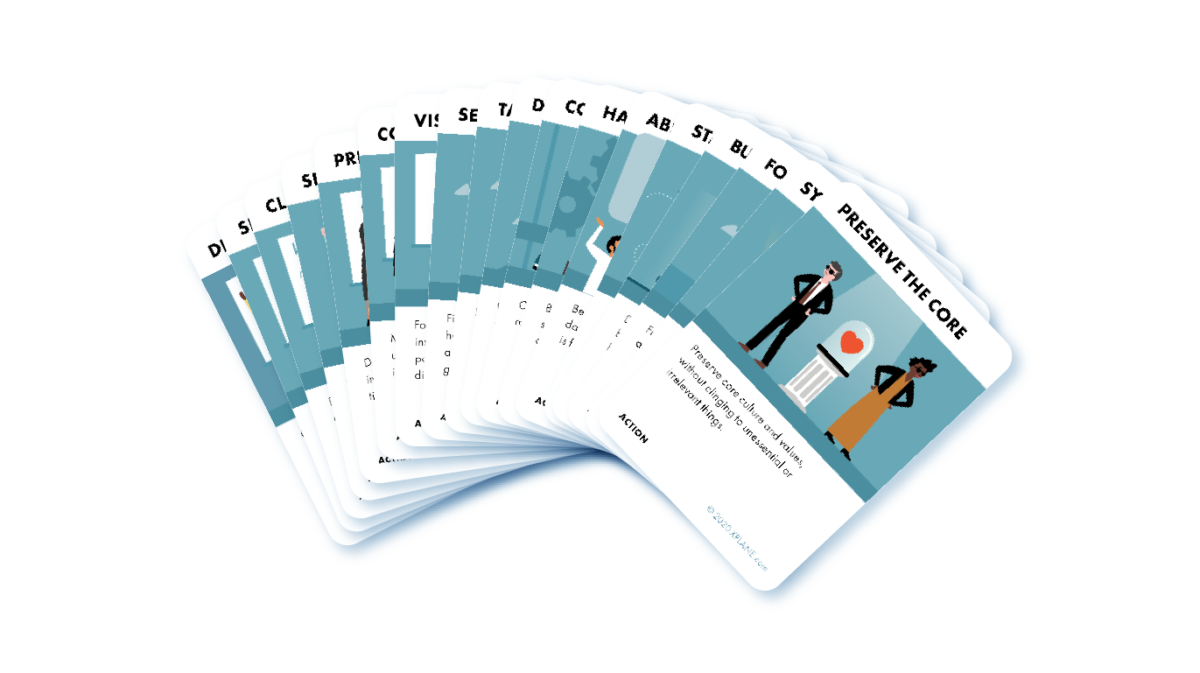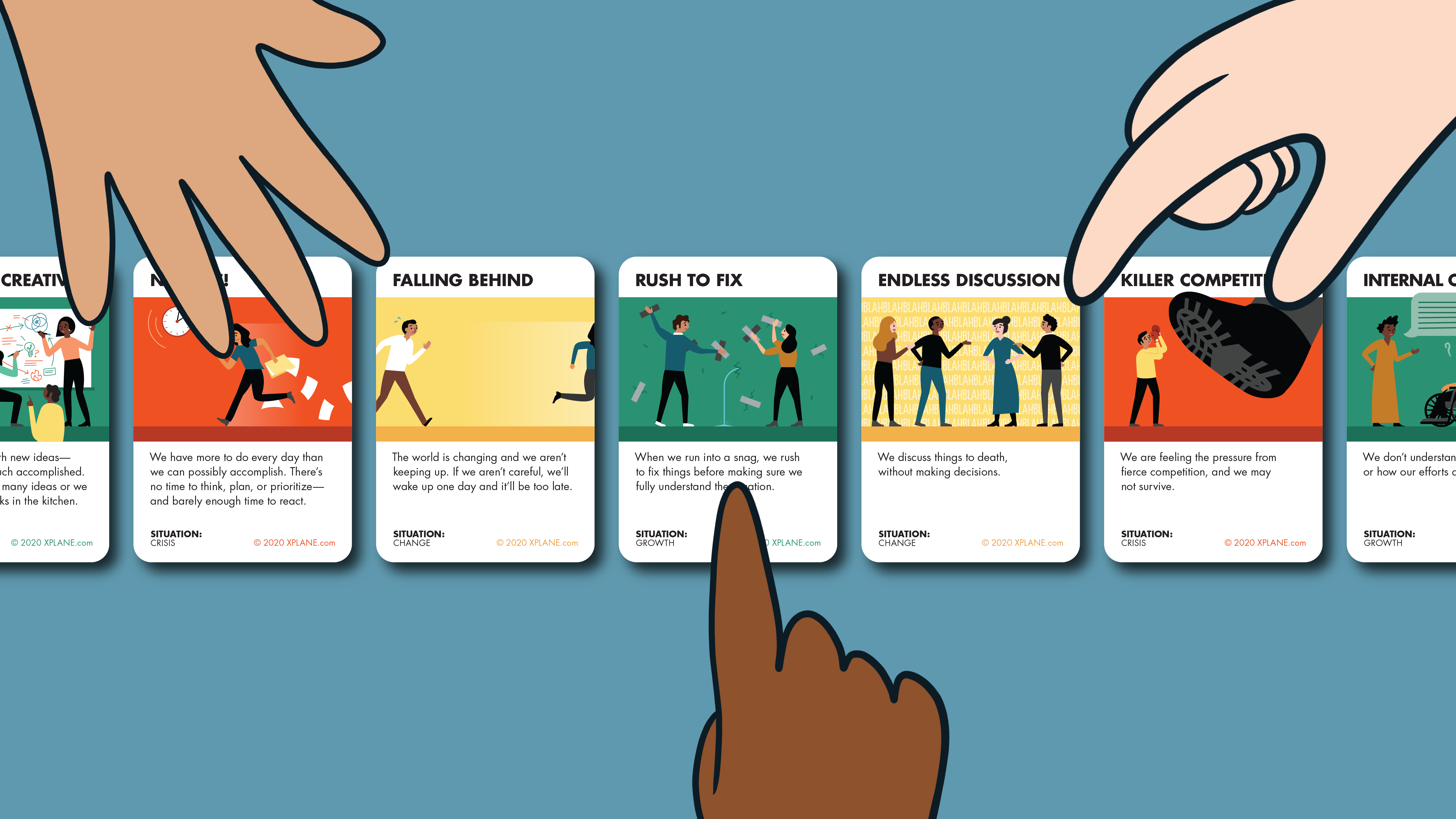Faced with a torrent of high-priority needs jostling for your attention? Calm the sea of demands with a card game that brings teams together to identify and prioritize challenges and determine solutions for a clear path forward.
After a year in which almost everything had to change radically in order for us to function at all, it’s not surprising that many of us feel a little underwater.
Timelines, competing priorities, tunnel vision, and reactive problem-solving bracket our thinking and prevent us from seeing our challenges clearly.
We’ve heard one organization describe team members working in a state they refer to as “the swirl,” where a whirlpool of constant high-priority needs was pulling them down.
The phrase alone paints quite a picture.
A Fun, Efficient Way to Create a Path Forward
The good news: EVERYONE is dealing with these issues. You are not alone if “the swirl” scenario sounds familiar.
The better news? We have a game that can help teams get past some of their own limitations and create a plan for moving forward.
XPLANE’s Discovery Cards can externalize our thinking, get us out of our own heads, help us align on a diagnosis and prioritization of current challenges, and can give us a path forward.
You might think this is a tall order for a humble deck of cards with pictures and scenarios on them.
But when used correctly, this tool can replace days of meetings and thousands of emails discussing organizational plans and challenges. It can also help you bypass some of the intra-office politics that often prevent meaningful change from happening.
How XPLANE’s Discovery Cards Work
Unfocused discovery can be a long and messy process, and it doesn’t always ladder up to the results leaders seek.
In contrast, XPLANE’s Discovery Cards create a prioritized list of initiatives and accountabilities that can guide your organization’s high-level priorities moving forward.
To use the cards, we recommend you name one facilitator and have anywhere from one to eight stakeholders participating.
A full Discovery Card session should take from 90 minutes to three hours, depending on the number of participants.
Assess the Current State
The discovery deck starts with an assessment of the current state.
Using the yellow, green, and red situation cards, the group should determine which scenarios are hits by quickly asking, “Does this sound like us?”
- Best practice: Have several people simultaneously do this exercise silently, each with their own card deck. This isn’t because we want to sell more card decks; it’s because working alone allows individuals to land on scenarios they find relevant without being influenced by the rest of the group.

As participants go through the scenarios, form a stack of hits and misses. A good facilitator will prompt thoughtful conversations when team members disagree over what is and what isn’t a relevant scenario the organization is currently facing.
- Pro tip: The facilitator should ask about situations negatively affecting the organization that aren’t depicted in the discovery cards (this is why there are wild cards for each section).
Prioritize Situations
Once the hits and misses have been selected, it’s okay to remove the misses from the table, and then spread out the hits to facilitate a group discussion around prioritizing them.
Do some of the hits have a cause-and-effect relationship? How might we prioritize the hits in terms of impact vs. effort?
At this point we’re looking for an agreed-upon, prioritized list of situations, ranking from most relevant to least.
It can be helpful to ask participants (1) what might happen if the primary selections aren’t addressed and (2) whether other team members have a different perspective on how the priorities might rank.
Brainstorm Solutions

Before jumping into the blue action cards, we suggest asking the team to step back for a moment and brainstorm potential solutions to the challenges listed. This ensures participants don’t limit their thinking to only what’s listed on the cards.
After participants write down some potential ideas for solutions, the facilitator then brings out the ACTION CARDS and asks participants to follow the same sorting procedure as they did with the situation cards.
- Pro tip: Remember to use wild cards for actions that aren’t listed in the deck.
Prioritize solutions based on what we now have uncovered about the challenges presented in the situation cards.
Accountability and Next Steps
Here is where gamification differs from gaming for entertainment.
Based on how solutions were prioritized, the facilitator and team can now break the solutions into near-term, middle, and long-term actions by assigning deadlines and accountabilities to these actions.
To go even further, the team can use the Recommend, Agree, Perform, Input, and Decide (RAPID) model to determine who makes decisions and which roles are needed to move forward with each action.
By the close of this activity, the team should feel as though they have diagnosed organizational challenges and made solid commitments that can be followed-up on—with some shared accountability for results.
Best Practices for Facilitators
This process will only work when people can be transparent and honest about what is limiting success.
For example, a mid-level manager may have a clear understanding of a situation negatively affecting the organization but doesn’t feel empowered to share that information as it may make his or her division look bad in front of senior management or potentially embarrass peers.
A skilled facilitator will let all participants know this is a safe space where internal power struggles and politics need to be muted to correctly diagnose problems and build plans to move forward.
It’s also always a good idea for facilitators to ask, “What are we missing?” This question helps participants consider scenarios outside of what’s depicted on the cards—and can spark valuable conversations.
Make Positive Change Happen
XPLANE’s Discovery Cards get to the heart of the issues at hand in a fun, (no pun intended) out-of-the-box way. We hope you use them to save time making positive change happen in the world. Good luck!
Additional Resources
For further reading on prioritizing work and finding a path forward, we recommend the following blog posts:
- Quickly Diagnose Your Organization’s Starting Point for Change
- Four Steps to Drive Positive Organizational Change
- How to Prioritize Projects in the Time of COVID
- Published on Forbes: Leadership Communication During Times Of Change: 10 Ways To Move Forward Together
As always, feel free to reach out if you have questions or comments on this post!
